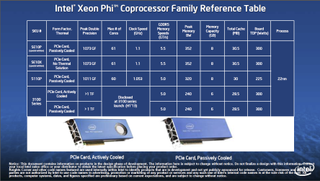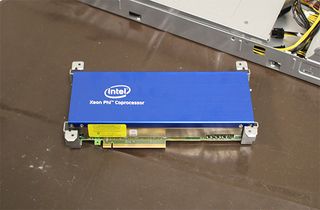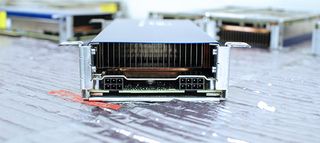Xeon Phi: Intel's Larrabee-Derived Card In TACC's Supercomputer
After eight years of development, Intel is finally ready to announce its Xeon Phi Coprocessor, which is derived from the company's work with Larrabee. Although the architecture came up short as a 3D graphics card, it shows more promise in the HPC space.
Intel Xeon Phi Hardware
Intel is launching one Knights Corner-based product family today: the Xeon Phi Coprocessor 5110P. It's expected to see general availability in early January of next year, and it's expected to cost just under $2700. Later on in 2013, we'll see Intel's Xeon Phi Coprocessor 3100-series.
Confused by all of the code names with Knights in them? Intel's product team has taken some criticism for repeated use of the word in its technology roadmaps. Here's the run-down, though:
- Knights Ferry (pre-production hardware)
- Knights Corner (2012-2013 product, now known as Xeon Phi)
- Knights Landing (second-gen product)

The Xeon Phi Coprocessor 5110P and 3100-series products are based on similar hardware, but wield specifications that more specifically target compute-bound applications. As you can see in the reference table above, Intel's two families employ different cooling solutions. The 5110P is passively-cooled, while the 3100-series will eventually ship in actively- and passively-cooled trims.
The 5110P includes more memory and greater peak bandwidth for workloads constrained by throughput. Add a 60-core processor running in excess of 1 GHz and you end up with a 225 W TDP. Although it doesn't feature active cooling, the 5110P still requires substantial airflow to dissipate all of that heat. As such, it's intended exclusively for rack-mounted servers with chassis fans able to force air through the card's heat sink and rear bracket.
Meanwhile, the 3100-series cards are specified for 300 W thermal limits. They'll only come armed with 6 GB of GDDR5 memory. And although Intel does come right out and say it, we can work backwards to figure out that a chip with 28.5 MB of L2 cache is going to give us 57 cores. Why the higher TDP, then? We have to assume they'll be running at higher clock rates. Like the 5110P, a passively-cooled Xeon Phi 3100 would require a properly-validated server system. But a model with its own fan might exist as a workstation solution.
Because Intel hosted the Xeon Phi launch event at the TACC, we were able to snap some photos of the cards as they were being installed.

To an enthusiast, the Xeon Phi looks a lot like two-slot graphics card with a 16-lane PCI Express interface. The two biggest differences, at least from this angle, are the lack of a cooling fan and the custom retention bracket. What you cannot see is the rear I/O panel, which is absent any display connectivity.
Stay on the Cutting Edge
Join the experts who read Tom's Hardware for the inside track on enthusiast PC tech news — and have for over 25 years. We'll send breaking news and in-depth reviews of CPUs, GPUs, AI, maker hardware and more straight to your inbox.

The large and heavy heat sink under the card's shroud has fins that go straight back, allowing air to flow through and out the front. More familiar are the eight- and six-pin auxiliary connectors responsible for complementing the slot's 75 W power delivery.
Current page: Intel Xeon Phi Hardware
Prev Page Intel Xeon Phi Architecture Next Page Intel Xeon Phi Performance-
mocchan Articles like these is what makes me more and more interested in servers and super computers...Time to read up and learn more!Reply -
wannabepro Highly interesting.Reply
Great article.
I do hope they get these into the hands of students like myself though. -
ddpruitt Intriguing idea....Reply
These X86 cores have the uumph to run something a little more complex than what a GPGPU can. But is it worth it and what kind of effort does it require. I'd have to disagree with Intel's assertion that you can get used to it by programming for an "i3". Anyone with a relatively modern graphics card can learn to program OpenCL or CUDA on there own system. But learning how to program 60 cores efficiently (or more) from an 8 core (optimistically) doesn't seem reasonable. And how much is one of these cards going to run? You might get more by stringing a few GPUs together for the same cost.
I'm wonder if this is going to turn into the same time of niche product that Intel's old math-coprocessors did. -
CaedenV man, I love these articles! Just the sheer amounts of stuffs that go into them... measuring ram in hundreds of TBs... HDD space in PBs... it is hard to wrap one's brain around!Reply
I wonder what AMD is going to do... on the CPU side they have the cheaper (much cheaper) compute power for servers, but it is not slowing Intel sales down any. Then on the compute side Intel is making a big name for themselves with their new (but pricy) cards, and nVidia already has a handle on the 'budget' compute cards, while AMD does not have a product out yet to compete with PHI or Tesla.
On the processor side AMD really needs to look out for nVidia and their ARM chip prowess, which if focused on could very well eat into AMD's server chip market for the 'affordable' end of this professional market... It just seems like all the cards are stacked against AMD... rough times.
And then there is IBM. The company that has so much data center IP that they could stay comfortably afloat without having to make a single product. But the fact is that they have their own compelling products for this market, and when they get a client that needs intel or nvidia parts, they do not hesitate to build it for them. In some ways it amazes me that they are still around because you never hear about them... but they really are still the 'big boy' of the server world. -
A Bad Day esrevermehReply
*Looks at the current selection of desktops, laptops and tablets, including custom built PCs*
*Looks at the major data server or massively complex physics tasks that need to be accomplished*
*Runs such tasks on baby computers, including ones with an i7 clocked to 6 GHz and quad SLI/CF, then watches them crash or lock up*
ENTIRE SELECTION IS BABIES!
tacoslavei wonder if they can mod this to run games...
A four-core game that mainly relies on one or two cores, running on a thousand-core server. What are you thinking? -
ThatsMyNameDude Holy shit. Someone tell me if this will work. Maybe, if we pair this thing up with enough xeons and enough quadros and teslas, we can connect it with a gaming system and we could use the xeons to render low load games like cod mw3 and tf2 and feed it to the gaming system.Reply -
mayankleoboy1 Main advantage of LRB over Tesla and AMD firepro S10000 :Reply
A simple recompile is all thats needed to use PHI. Tesla/AMD needs a complete code re write. Which is very very expensive .
I see LRB being highly successful. -
PudgyChicken It'd be pretty neat to use a supercomputer like this to play a game like Metro 2033 at 4K, fully ray-traced.Reply
I'm having nerdgasms just thinking about it.
Most Popular






